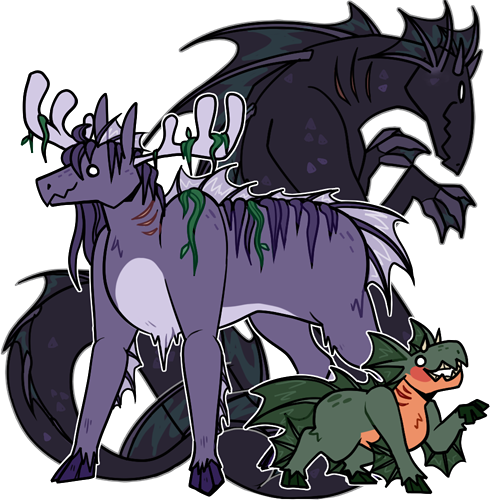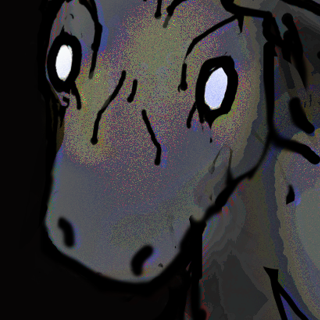[Cosmosdex] The Universal Encyclopedia
[Cosmosdex]
Pacoose
Mermeese / Kelpies
Pacoose

Art by, nemmie
- Strength-9
- Intelligence-1
- Charisma-1
- Endurance-10
- Agility-5
- Luck-0
Common Jobs: Security, Life guards, Ferries, Living Barricades
Likes: Algae, Kelp, Snacks, Food
Dislikes: Competition, Other pacoose
Attack Method: Will bluff charge when threatened. If the perceived threat continues they will ram into the attacker with their horns to send them flying/ knock them to the ground, then use their front hooves to disable the attacker.
Attributes
Homeplanet: CanoceadaLifespan: 70 years
Size: 6.0 ft tall, 7.9 ft long
Diet: Plants, Fish
Bodytype: Quadruped
Type: Mammalian Amphibian
Social Class: Lowest Class
Rarity: Rare
Common Traits
This character doesn't need others to function and doesn't lose morale or sanity on an empty ship. They are self sustainable but may be prone to staying away from groups.
This character is known for being very durable and hard to break.
This character is always the first character to eat once the table is set, and no one else would dare sit down with them. If anyone attempts to take, touch, or even look at their food they may become very aggressive. If a food aggressive character runs out of food they will do anything to get their next meal, even if it means ripping it off a co-worker. This character will also be unwilling to give food to a starving character to the point where they will put their eating habits over their life.
Gods
Pacoose don't have any semblance of organized religion. At most, a space-faring pacoose might passively mention they believe in a god the aliens around them do, even if they don't understand the intricacies of the religion.
Gods: None
Original Creator: nemmie
Physical Description
Pacoose have a bulky, tankish, short-necked equine build. Their front most shoulder bones are prominent, causing a "hump" in their silhouette. Gills are located on their neck, and while big in youth, will grow slimmer in adulthood and will shut to prevent infection when not actively being used.
They are quadrupeds, all having four legs and four hooves— of which these hooves are segmented into three finger-like parts, each with webbing hidden in between. All adult paceese have residual fins from their youth, causing a flattened, delicate mane of fin while they roam on land- which frills up when the pacoose chooses to forage underwater.
Their faces are strong jawed and rigid, with a serrated-esque mouth that opens to reveal two small, sharp teeth on the bottom and top row- while the rest are flatter molars. The small eyes of a pacoose are reflective allowing them to pierce through and see even in deeper, darker waters. Due to this they often appear striking white.
While they spend most of their time wading in the water, pacoose have developed temperature-resistant hair to keep them slightly warmer on land. This is most noticeable via their manes, bangs, belly fur, and the backs of their legs– all locations near their residual fins from youth.
This hair may elegantly float and curl while underwater, but as soon as a pacoose rises from the depths it flops down and sticks to their body. Thanks to the properties of this hair, it does not absorb any of the cold from the water, but protects their residual fins and traps the body heat inside. Freshly risen pacoose are often covered in algae and other marine plants, causing them to be likened to unruly swamp beasts.
Pacoose have no sexual dimorphism aside from antlers. Males are antlered, but even so, they're only antlered during specific months of the year— after which these will be shed. These antlers are often long, heavy, obtrusive, and stick out either at the side or front of the head. They're vaguely hand-shaped, and are used in combat with other males over competition with females. Some pacoose (both male and female) are known to have an odd mutation that causes "year round" bumps for horns. These bump-heads will either never be able to grow true horns, or in the case of males- may cause them to grow their springtime horns in the incorrect place. I.e more towards their neck.
Baby pacoose look more like fish than a mammal, and spend all of their time underwater. They're hairless, with much more prominent back fins, limb-webbing, and back feet "tails". Their ears are large head fins that will transform towards adulthood. Babies are born with their back legs fused together by a membrane, forcing the clasped legs to work as a tail. As the pacoose grows, this membrane will wear thin, and eventually break with the force of movement.
Personality
Pacoose are peaceful. Left alone and unprovoked, they simply walk the land in search of food. The problem arises when they perceive competition, especially regarding said meal. On their home planet of Canoceada, the weather is cold almost entirely year-round, and food sources are often scarce. Being solitary creatures who don't stick in herds, they perceive others as threats to their survival.
Since being introduced to space, well-fed pacoose have been able to work surprisingly fine alongside aliens. While they still cannot work with one another, a pacoose is far more unlikely to perceive an alien as an unwelcome competitor, only doing so when rations dwindle and hunger becomes a problem.
Typically, aliens will perceive pacoose as friendly, gentle giants. They're tolerant of being poked, prodded, climbed on, and spoken to. So much so that they're often entrusted as short-term babysitters for children.
So long as nobody is actively violent and aggressive, or threatening to steal their rations, a pacoose won't feel the need to be offensive.
Pacoose are incredibly food motivated, and will instantly become friends with someone who generously shared their lunch- especially as a pacoose would NEVER even consider doing so, not even with their closest companions. It's entirely possible to pay a pacoose for a job (or friendship) in rations and nothing else.
Riding a pacoose easily becomes possible with a carrot-on-a-stick method, however it's more likened to riding a crazed mechanical bull than a proper steed. In any case, a pacoose would prefer permission be granted before riding them.
In the case of wasted food, a pacoose won't grow aggressive, but rather distressed. They may attempt to eat the food right out of the trash- even if the food is inedible to them- if they become too upset over it. A pacoose will cry and wail over a dropped plate of spaghetti.
History
When pacoose were first discovered, they were considered "highly hazardous local fauna". Those who landed on Canoceada were collecting samples of the local plant life- only for one of their field researchers to be suddenly sent flying by a charging pacoose. Another incident soon followed, in which a group of scientists in a land rover collided with a pacoose, only for the pacoose to remain unharmed. The vehicle suffered damages akin to a car speeding into a brick wall, there were no fatalities, but the frontmost occupants were concussed and trapped within the crumpled wreckage until help arrived. The first attempt to ride a pacoose was met with immediate death, as the pacoose quickly panicked and retreated to the water, causing the unfortunate rider to drown.
It took a fair amount of time to pass before pacoose were discovered to be complex, intelligent beings. Seeing as pacoose are extremely solitary and do not raise their young, they had no common culture or civilization to speak of. When researchers began to attempt domestication with the incentive of food, they were quickly witness to the pacoose's critical thinking skills. They could learn and remember where the scientists stored their rations, even raising their legs and utilizing their hoof-like fingers to open the fridge handles. It got to the point pacoose began mimicking their words, combining existing words to make words for they didn't know― which they mostly used to ask for different treats and snacks, or talk about how they prefer one snack over the other.
Home Planet
For most of the year- if not pretty much all of it- Canoceada is cold. The planet's surface is covered in brackish swampland, marshes, and lakes. Most of the life can be found under the water- or the ice, depending on the season- where aquatic plants and fish thrive. There's evidence that leads science to believe Canoceada wasn't always subject to frigid temperatures, nor was it always so flooded. Many animals on the planet evolved to retreat into the water when the life on land began to freeze. But, evidence shows the pacoose started as marine life and evolved their way out. This caused the pacoose not only to be part of the exclusive land dwelling handful of inhabitants on Canoceada, but to also have no natural predators on land.
Both freshwater and saltwater life exists in different segments of Canoceada, but since most connecting water is brackish most animals, algae, and trees are adapted to the water regardless of salinity. It's a unique menagerie of kelp, coral, mangroves, reeds, lily pads, and other undiscovered wonders.
Subspecies
Eeleese: An extremely rare sight and mostly unknown, Eeleese are supposedly pacoose who never left the water. As young, their attached legs simply fuse together into long, snake-like tails, leaving only their front hooves usable. Their fins never shrink nor flatten, resulting in a spiky, all over deep-sea appearance. They live in the depths of salty marshes on their homeplanet and never go on land. Eeleese are far more aggressive, active hunters, and have attacked the divers attempting to research them unprovoked.
Pacana: Pacana are smaller, nearly baby-sized, pacoose who spend most of their time in the water. Like the eeleese, they primarily feed on fish, and secondly aquatic vegetation. Pacanas, unlike regularpacoose, are more social- often traveling in packs to make up for their lack of bulk, durability, and size. While they keep their ear-like fins from youth, they do not lose the ability to walk on land like the eeleese— they just often choose not to.
However, when they do, it can be quite a surprise. The first pacanas discovered had all jumped out of the water at once, prancing towards unsuspecting researchers and chasing them away before raiding their camp for snacks.
Special
Still Standing: The rumors are true! Pacoose have an uncanny ability to be hit by vehicles (and creatures) far larger than they are and suffer very little injury in response. They're built like brick walls and aren't coming down anytime soon.
Trivia
• It was only later discovered that pacoose also eat bark, twigs, and leaves from trees. While bark could be scraped off with their hooves, and twigs from the ground- in order to obtain the tasty treats above, pacoose apparently full on ram into the trees with their bodies to rustle the branches, often knocking the tree over in the process.
• Pacoose do not like the heat due to the constant cold of their homeplanet. A pacoose who lives in a hot climate requires easy access to water cool off because of their inability to sweat.
• Playing fetch with a pacoose always ends in the pacoose eating the stick, scientists conclude.



